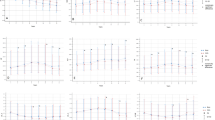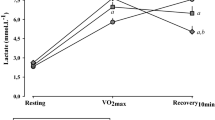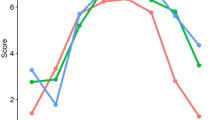Abstract
Heart rate (HR) has been widely studied as a measure of an individual's response to painful stimuli. It remains unclear whether changes in mean HR or the variability of HR are specifically related to the noxious stimulus (i.e. pain). Neither is it well understood how such changes reflect underlying neurologic control mechanisms that produce these responses, or how these mechanisms change during the first year of life. To study the changes in cardiac autonomic modulation that occur with acute pain and with age during early infancy, the relationship between respiratory activity and short-term variations of HR (i.e. respiratory sinus arrhythmia) was quantified in a longitudinal study of term born healthy infants who underwent a finger lance blood collection at 4 months of age (n = 24) and again at 8 months of age (n = 20). Quantitative respiratory activity and HR were obtained during baseline, lance, and recovery periods. Time and frequency domain analyses from 2.2-min epochs of data yielded mean values, spectral measures of low (0.04-0.15 Hz) and high (0.15-0.80 Hz) frequency power (LF and HF), and the LF/HF ratio. To determine sympathetic and parasympathetic cardiac activity, the transfer relation between respiration and HR was used.
At both 4 and 8 months, mean HR increased significantly with the noxious event (p > 0.01). There were age-related differences in the pattern of LF, HF, and LF/HF ratio changes. Although these parameters all decreased (p > 0.01) at 4 months, LF and LF/HF increased at 8 months and at 8 months HF remained stable in response to the noxious stimulus. Transfer gain changes with the lance demonstrated a change from predominant vagal baseline to a sympathetic condition at both ages. The primary finding of this study is that a response to an acute noxious stimulus appears to produce an increase in respiratory-related sympathetic HR control and a significant decrease in respiratory-related parasympathetic control at both 4 and 8 months. Furthermore, with increasing age, the sympathetic and parasympathetic changes appear to be less intense, but more sustained.
Similar content being viewed by others
Log in or create a free account to read this content
Gain free access to this article, as well as selected content from this journal and more on nature.com
or
Abbreviations
- HRV:
-
heart rate variability
- RSA:
-
respiratory sinus arrhythmia
- LF:
-
low frequency
- HF:
-
high frequency
- RP:
-
respiratory power
- As:
-
sympathetic gain factor
- Ap:
-
parasympathetic gain factor
References
Porter FL, Porges SW, Marshall RE 1988 Newborn pain cries and vagal tone: parallel changes in response to circumcision. Child Dev 59: 495–505.
Anand KJS, Aynsley-Green A 1988 Measuring the severity of surgical stress in newborn infants. J Pediatr Surg 23: 297–305.
Anand KJS 1990 Neonatal stress responses to anesthesia and surgery. Clin Perinatol 17: 207–214.
Randich A, Maixner W 1984 Interactions between cardiovascular and pain regulatory systems. Neurosci Biobehav Rev 8: 343–367.
Owens ME, Todt EN 1984 Pain in infancy: neonatal reaction to heel lance. Pain 20: 77–86.
Beaudoin CA, James M, McAllister M 1991 The physiological response of premature infants to heelstick blood sampling. J Pain Sympt Manag 6: 193
Grunau RE, Oberlander T, Hoslti L, Whitfield M 1998 Bedside application of the Neonatal Facial Coding System in pain assessment of premature neonates. Pain 76: 277–286.
McIntosh N, Van Veen L, Brameyer H 1993 The pain of heel prick and its measurement in preterm infants. Pain 52: 71–74.
Johnston CC, Stevens B, Craig KD, Grunau RVE 1993 Developmental changes in pain expression in premature, full-term, two- and four-month-old infants. Pain 52: 201–208.
Lewis M, Thomas D 1990 Cortisol release in infants responding to inoculation. Child Dev 61: 50–59.
Johnston CC, Stevens BJ, Yang F, Horton L 1995 Differential responses to pain by very premature neonates. Pain 61: 471–479.
Craig KD, Whitfield MF, Grunau RV, Linton J, Hadjistavropoulos HD 1993 Pain in the preterm neonate: behavioural and physiological indices. Pain 52: 287–299.
Woodrow-Benson D 1995 The normal electrocardiogram. In: Emmanouilides GC, Allen HD, Riemenschneider TA, Guttgesell HP (eds) Heart Disease in Infants Children and Adolescents. Williams and Wilkins, Baltimore, 160
Lagercrantz H, Edwards D, Henderson-Smart D, Hertzberg T, Jeffery H 1990 Autonomic reflexes in preterm infants. Acta Paediatr Scand 79: 721–728.
Finley JP, Hamilton R, MacKenzie MG 1984 Heart rate response to tilting in newborns in quiet and active sleep. Biol Neonate 45: 1–10.
Dohi S, Naito H, Takahashi T 1979 Age-related changes in blood pressure and duration of motor block in spinal anesthesia. Anesthesiology 50: 319–23.
Johnston CC, Stevens BJ, Yang F, Horton L 1996 Developmental changes in response to heelstick in preterm infants: a prospective cohort study. Dev Med Child Neurol 38: 438
Saul JP, Berger RD, Albrecht P, Stein SP, Chen MH, Cohen RJ 1991 Transfer function analysis of the circulation: unique insights into cardiovascular regulation. Am J Physiol 261:H1231–H1245.
Fox NA, Porges SW 1985 The relation between neonatal heart period patterns and developmental outcome. Child Dev 59: 28–37.
Litvack DA, Oberlander TF, Carney LH, Saul JP 1995 Time and frequency domain methods for heart rate variability analysis: a methodological comparison. Psychophysiology 32: 492–504.
Oberlander TF, Berde CB, Lam KH, Rappaport LA, Saul JP 1995 Infants tolerate spinal anesthesia with minimal overall autonomic changes: transfer function analysis of respiratory sinus arrhythmia in former premature infants undergoing hernia repair. Anesth Analg 80: 20–27.
Oberlander TF, Berde CB, Lam KH, Saul JP 1996 Halothane causes withdrawal of cardiac sympathetic modulation in infants: transfer function analysis of respiratory sinus arrhythmia. Pediatr Res 40: 710–717.
Hanna BD, Saul JP, Cohen RJ, Stark AR 1990 Transfer function analysis of respiratory sinus arrhythmia: developmental changes in sleeping premature infants. Circulation 82( suppl III): 334.
Prechtl HF 1974 The behavioral states of the newborn infant (a review). Brain Res 76: 185–212.
Boston Medical Technologies 1996 HR View Software, Boston MA.
Brouillette RT, Morrow AS, Weese-Mayer DE, Hunt CE 1987 Comparison of respiratory inductive plethysmography and thoracic impedance for apnea monitoring. J Pediatr 111: 377–383.
Berger R, An efficient algorithm for spectral analysis of heart rate variability. IEEE Transactions on Biomedical Engineering 33: 900–904.
Johnston CC, Stevens BJ, Yang F, Horton L 1996 Developmental changes in response to heelstick in preterm infants: a prospective cohort study. Dev Med Child Neurol 38: 438–445.
Berger RD, Saul JP, Cohen RJ 1989 Transfer function analysis of autonomic regulation. I. Canine atrial rate response. Am J Physiol 256:H142–H152.
Angelone A, Coulter NA 1964 Respiratory sinus arrhythmia: a frequency dependent phenomenon. J Appl Physiol 19: 479–482.
Eckberg DL 1983 Human sinus arrhythmia as an index of vagal cardiac outflow. J Appl Physiol 54: 961–966.
Nuwayhid B, Brinkman CR, Su C, Bevan JA, Assali NS 1975 Development of autonomic control of fetal circulation. Am J Physiol 228: 337–344.
Chatow U, Davidson S, Reichman BL, Akselrod S 1995 Development and maturation of the autonomic nervous system in premature and full-term infants using spectral analysis of heart rate fluctuations. Pediatr Res 37: 294–302.
Snidman N, Kagan J, Riordan L, Shannon DC 1995 Cardiac function and behavioral reactivity during infancy. Psychophysiology 32: 199–207.
Harper RM, Walter DO, Leake B, Hoffman HJ, Sieck GC, Sterman MB, Hoppenbrouwers T, Hodgman J 1978 Development of sinus arrhythmia during sleeping and waking states in normal infants. Sleep 1: 33–48.
Schechtman VL, Harper RM, Kluge KA 1989 Development of heart rate variation over the first 6 months of life in normal infants. Pediatr Res 26: 343–346.
Anand KS, Grunau RE, Oberlander TF 1997 Developmental character and long-term consequences of pain in infants and children. Child Adolesc Psychiatr Clin North Am 6: 703–724.
Hirsch JA, Bishop B 1981 Respiratory sinus arrhythmia in humans: how breathing pattern modulates heart rate. Am J Physiol 241:H620–H629.
Acknowledgements
The authors thank Colleen Fitzgerald, Ann-Louise Ellwood, Jacqueline Smit Alex, Herb Chan, and the staff of the Newborn Nursery at BC Women's Hospital for their invaluable contributions.
Author information
Authors and Affiliations
Additional information
This study was supported by a grant from the British Columbia Health Research Foundation.
Rights and permissions
About this article
Cite this article
Oberlander, T., Grunau, R., Pitfield, S. et al. The Developmental Character of Cardiac Autonomic Responses to an Acute Noxious Event in 4- and 8-Month-Old Healthy Infants. Pediatr Res 45, 519–525 (1999). https://doi.org/10.1203/00006450-199904010-00011
Received:
Accepted:
Issue date:
DOI: https://doi.org/10.1203/00006450-199904010-00011
This article is cited by
-
The newborn infant parasympathetic evaluation index for acute procedural pain assessment in preterm infants
Pediatric Research (2021)
-
Newborn infant parasympathetic evaluation (NIPE) as a predictor of hemodynamic response in children younger than 2 years under general anesthesia: an observational pilot study
BMC Anesthesiology (2019)
-
NIPE is related to parasympathetic activity. Is it also related to comfort?
Journal of Clinical Monitoring and Computing (2019)



